Optical amplifier is an important technology for optical communication networks. Without the need to first convert it to an electrical signal, the optical amplifiers are now used instead of repeaters. As we know, there are several types of optical amplifiers. Among them, the main amplifier technologies are Doped fiber amplifier (eg. EDFA), Semiconductor optical amplifier (SOA) and Fiber Raman amplifier. Today, we are going to study and compare different types of optical amplifiers in this paper.
Before the comparison of the different types of optical amplifiers, let’s take a closer look at fiber optic amplifier. In general, a repeater includes a receiver and transmitter combined in one package. The receiver converts the incoming optical energy into electrical energy. The electrical output of the receiver drives the electrical input of the transmitter. The optical output of the transmitter represents an amplified version of the optical input signal plus noise. Repeaters do not work for fiber-optic networks, where many transmitters send signals to many receivers at different bit rates and in different formats. However, unlike a repeater, an optical amplifier amplify optical signal directly without electric and electric optical transformation. In addition, an ideal optical amplifier could support multi-channel operation over as wide as possible a wavelength band, provide flat gain over a large dynamic gain range, have a high saturated output power, low noise, and effective transient suppression. Several benefits of optical amplifiers as the following:
- Support any bit rate and signal format
- Support the entire region of wavelengths
- Increase the capacity of fiber-optic links by using WDM
- Provide the capability of all-optical networks, not just point-to-point links
OK, after a brief introduction of the optical amplifiers, we formally begin today’s main topic. As we talk above, there are three main types of today’s amplifier technology. Each of them has their own working principle, features and applications. We will describe them one by one in the following paragraphs.
Doped fiber amplifier (The typical representative: EDFA)
Erbium-doped fiber amplifier (EDFA) is the most widely used fiber-optic amplifiers, mainly made of Erbium-doped fiber (EDF), pump light source, optical couplers, optical isolators, optical filters and other components. Among them, a trace impurity in the form of a trivalent erbium ion is inserted into the optical fiber’s silica core to alter its optical properties and permit signal amplification.
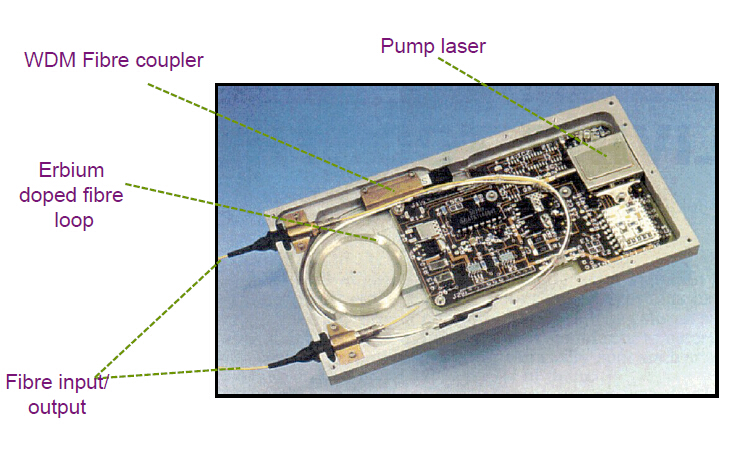
Working Principle
The working principle of the EDFA is to use the pump light sources, which most often has a wavelength around 980 nm and sometimes around 1450 nm, excites the erbium ions (Er3+) into the 4I13/2 state (in the case of 980-nm pumping via 4I11/2), from where they can amplify light in the 1.5-μm wavelength region via stimulated emission back to the ground-state manifold 4I15/2.
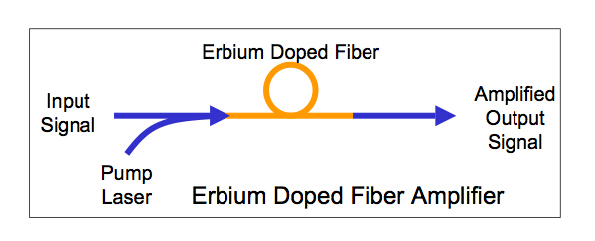
Advantages & Disadvantages of EDFA
Advantages
- EDFA has high pump power utilization (>50%)
- Directly and simultaneously amplify a wide wavelength band (>80nm) in the 1550nm region, with a relatively flat gain
- Flatness can be improved by gain-flattening optical filters
- Gain in excess of 50 dB
- Low noise figure suitable for long haul applications
Disadvantages
- Size of EDFA is not small
- It can not be integrated with other semiconductor deviecs
Semiconductor optical amplifier (SOA)
Semiconductor optical amplifier is one type of optical amplifier which use a semiconductor to provide the gain medium. They have a similar structure to Fabry–Perot laser diodes but with anti-reflection design elements at the end faces. Unlike other optical amplifiers SOAs are pumped electronically (i.e. directly via an applied current), and a separate pump laser is not required.
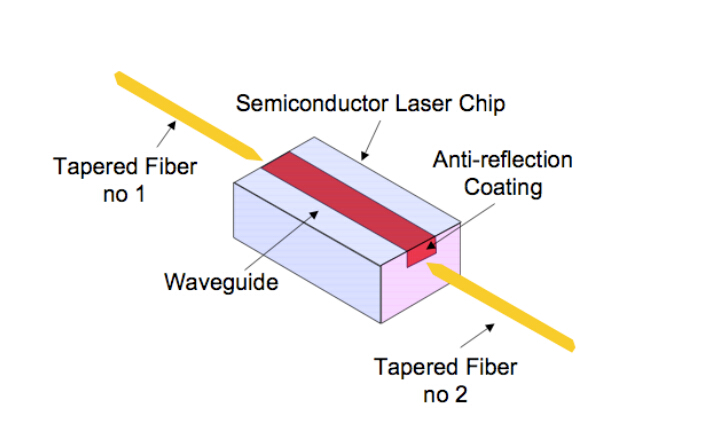
Working Principle
1.Stimulated emission to amplify an optical signal.
2.Active region of the semiconductor.
3.Injection current to pump electrons at the conduction band.
4.The input signal stimulates the transition of electrons down to the valence band to acquire an amplification.
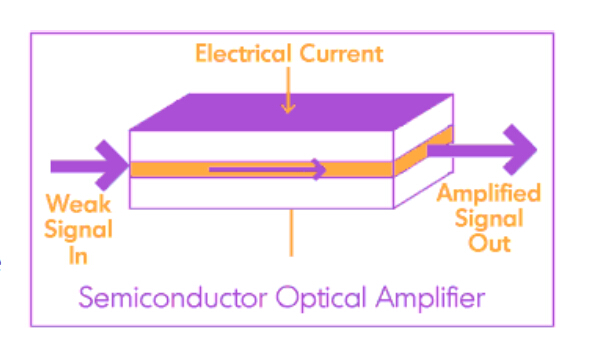
Advantages & Disadvantages of SOA
Advantages
- The semiconductor optical amplifier is of small size and electrically pumped.
- It can be potentially less expensive than the EDFA and can be integrated with semiconductor lasers, modulators, etc.
- All four types of nonlinear operations (cross gain modulation, cross phase modulation, wavelength conversion and four wave mixing) can beconducted.
- SOA can be run with a low power laser. This originates from the short nanosecond or less upper state lifetime, so that the gain reacts rapidly tochanges of pump or signal power and the changes of gain also cause phase changes which can distort the signals.
Disadvantages
The performance of SOA is still not comparable with the EDFA. The SOA has higher noise, lower gain, moderate polarization dependence and high nonlinearity with fast transient time.
Fiber Raman amplifier (FRA)
Fiber Raman Amplifier (FRA) is also a relatively mature optical amplifier. In a FRA, the optical signal is amplified due to stimulated Raman scattering (SRS). In general, FRA can is divided into lumped type called LRA and distributed type called DRA. The fiber gain media of the former is generally within 10 km. In addition, it requires on higher pump power, generally in a few to a dozen watts that can produce 40 dB or even over gains. It is mainly used to amplify the optical signal band of which EDFA cannot satisfy. The fiber gain media of DRA is usually longer than LRA, generally for dozens of kilometers while pump source power is down to hundreds of megawatts. It is mainly used in DWDM communication system, auxiliarying EDFA to improve the performance of the system, inhibiting nonlinear effect, reducing the incidence of signal power, improving the signal to noise ratio and amplifing online.
Working Principle
The principle of FRA is based on the Stimulated Raman Scattering (SRS) effect. The gain medium is undoped optical fiber. Power is transferred to the optical signal by a nonlinear optical process known as the Raman effect. An incident photon excites an electron to the virtual state and the stimulated emission occurs when the electron de-excites down to the vibrational state of glass molecule. The Stokes shift corresponding to the eigen-energy of a phonon is approximately 13.2 THz for all optical fibers.
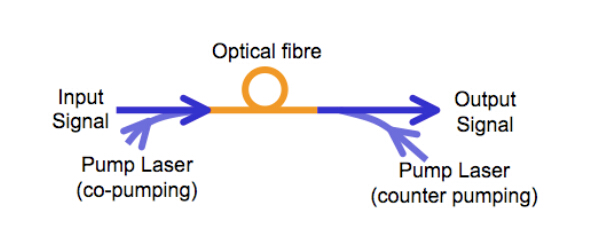
Advantages & Disadvantages of FRA
Advantages
- Variable wavelength amplification possible
- Compatible with installed SM fiber
- Can be used to extend EDFAs
- Can result in a lower average power over a span, good for lower crosstalk
- Very broadband operation may be possible
Disadvantages
- High pump power requirements, high pump power lasers have only recently arrived
- Sophisticated gain control needed
- Noise is also an issue
Summary
After talking about these three types of optical amplifiers, we make a comparison of them as the following table.

Related Article: Differences Between Pre-Amplifier, Booster Amplifier and In-line Amplifier
Related Article: Optical Amplifier – EDFA (Erbium-doped Fiber Amplifier) for WDM System
